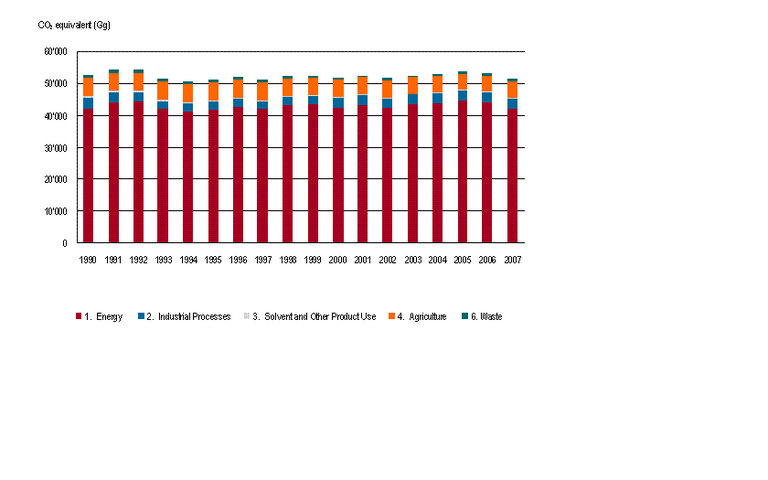Published: 26 Nov 2010
Modified: 17 Feb 2025
Greenhouse gas emissions in Switzerland have remained relatively constant since 1990. Carbon dioxide (CO2) accounts for 85 % of total greenhouse gas emissions. In 2007, Switzerland emitted 51.3 million tonnes CO2 equivalents, to which CO2 contributed 43.6 million tonnes. Methane (CH4) emissions have dropped by 19 % and nitrous oxide (N2O) emissions by 10 % since 1990, with agriculture as the main source of these two gases. The use of synthetic gases has risen markedly since 1990, contributing 1.7 % to the national total in 2007.
In Switzerland, the observed temperature increase of 0.39°C per decade for the period 1961-2009 was accompanied by changes in several climate indicators. For instance, temperature extremes and the number of hot days and tropical nights increased whereas the extent of the average winter snow cover diminished and the seasonal freezing level (altitude, where surface air temperature is 0°C) has risen. Changes in precipitation were less pronounced than long-term changes in mean temperatures. However, a number of stations reveal a significant increase in precipitation in winter and spring (+2.7 to +3.1 % per decade; OcCC, 2008).
The observed changes had significant impacts on several natural and anthropogenic systems. Most prominent are the changes in the cryosphere. Between 1975 and 2000, Alpine glaciers lost about 25 % of their volume. A recent analysis has revealed that 12 % of the volume of Swiss glaciers was lost since 1999 (Farinotti et al., 2009).
Also water availability is affected in Switzerland. Despite the fact that Switzerland is in a favourable situation compared to other regions of the world, having about 5560 m3 of water available per year and inhabitant, long-term changes in snow cover and glaciation will have irreversible effects on run-off regimes. As a result, the generation of hydropower is expected to decrease (e.g. Piot, 2005) and the demand for irrigation in agriculture will grow (Fuhrer and Jasper, 2009).
One of the biggest concerns in Switzerland with respect to climate change is the evolution of natural hazards. The retreat of Alpine glaciers results in a decrease in slope stability as described above. Mud slides and rockfall, as experienced for example in Grindelwald in 2006, are expected to become more frequent. In addition, the expected thawing of permafrost represents a costly risk for a vast array of transport infrastructures in the mountains. At lower altitudes, the risk of winter and spring floods is likely to increase due to the fact that precipitation increasingly falls as rain instead of snow, and due to the growing frequency and intensity of heavy precipitation events (KOHS, 2007). In contrast, summer floods on the central plateau are expected to become smaller.
With present knowledge, it is expected that the consequences of rising temperatures will be manageable for Switzerland up to the mid-21st century. The precondition to this is that warming remains within the anticipated range. Nevertheless, several sectors will face big challenges due to climate change within this period and substantial adaptive measures will be necessary. These measures will require significant financial resources. However, compared to the costs of inaction, which were estimated in a previous study to amount to 0.2 % GDP in 2050 and increase to about 0.5 % GDP by the year 2100 (FOEN, 2007), the cost of timely adaptation will only be a small fraction in comparison to this large amount.
Greenhouse gas emissions by sector

Contribution of individual gases to Switzerland's greenhouse gas emissions in 2008

Document Actions
Share with others